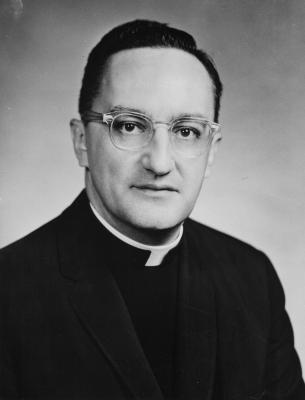President: 1964-1969
Fr. Gerard Campbell, S.J., served as Georgetown's 44th president from 1964-1969. Fr. Campbell's tenure is most notable for his reforms to the university's charter and faculty, as well as plans for constructing a new library.
Early Academic Career
Gerard Campell joined the Jesuits in 1939 and received A.B. and Ph.L degrees from Loyola University, Chicago and a licentiate in sacred theology (S.T.L.) from Woodstock College before his ordination in 1951. Fr. Campbell taught at St. Joseph’s College, then earned his Ph.D. in history from Princeton University in 1957, before teaching at Loyola College in Baltimore. In 1963, Fr. Campbell came to Georgetown where he served as Executive Vice President. On December 3, 1964, Fr. Campbell succeeded Fr. Bunn and became the University’s forty-fourth president and the first who earned his doctorate at an American non-Catholic university.1
Reforms
Fr. Campbell began his term by reviewing the University’s charter and bylaws, and he soon began the process of amending the bylaws to allow for the separation of the Corporation from the Board of Directors. The Corporation was to become five persons whose sole purpose was to meet annually and elect their own members and the members of the Board of Directors. The Board of Directors was to number ten to twenty-five persons and operate as the University's policy making body and governing authority. With these changes, the University transformed into an autonomous entity, legally independent from the Jesuits, and in 1966, Congress formally ratified the University’s new charter.2
Another top priority of his presidency, Fr. Campbell worked to improve the quality and prestige of the University’s faculty. He began with the hiring process, instructing departments to pursue organized and advertised faculty searches, and overseeing the University’s first Affirmative Action plan for the hiring of women and African Americans. Jesuits also began receiving University appointments at a higher rate than when they were assigned to the University under the old charter. In 1968, the Maryland Province made the University its top educational priority, giving Georgetown first choice of Jesuits seeking academic positions.3
Fr. Campbell facilitated the creation of a Faculty Senate, which the board and the faculty formally approved in 1967. A system for regulating faculty sabbaticals and annual contracts were both introduced shortly thereafter. The following year, Fr. Campbell approved a University-wide rank and tenure committee to review and recommend applications for tenure and promotion.4
Library Planning and Construction
Early in his presidency, Fr. Campbell inherited the task of building new libraries for the main campus and medical campus. Fr. Bunn had formally committed the University to building a new main campus library and oversaw the selection of Charles Warnecke as the architect. Under Fr. Campbell, the University applied for partial federal funding and navigated the selection of a site. Through Title Three of the Higher Education Facilities Act, the University received $4.6 million but was forced to fund the remaining $1.5 million.
Original plans to build the new library on the southeast corner of 37th and O Streets fell through after they were opposed by the National Capital Planning Commission, the Fine Arts Commission, the Board of Zoning Adjustment, and the Georgetown Citizens Association. Selecting a design that the Fine Arts Commission approved took an additional year. Then, six months before breaking ground, the administration demanded the designers rethink the library’s first two floors to accommodate faculty offices, classrooms, and the bookstore. In the spring of 1968, the University finally broke ground on the new library.5
That same year, the University was projected to end the fiscal year with a $1.5 million deficit, for the second year in a row. Fr. Campbell oversaw the University’s implementing of strict remedial efforts, reporting “the financial position of the University will be seriously threatened if these efforts at economy are not pursued vigorously.”6 Schools were barred from exceeding the previous year’s expenses by more than 5%, unfunded scholarships and fellowships were reduced, and tuition increased. As a result, the University was able to lower the anticipated deficit of $1.5 million to $220,000 for 1968.
Resignation
On June 13, 1968, citing his desire to return to teaching and research, Fr. Campbell submitted his letter of resignation to the Board of Directors. Fr. Campbell agreed to remain in office while the newly appointed presidential search committee chose his successor. 7On December 30, 1968, the University selected Fr. Robert Henle, and Fr. Campbell officially stepped down as University president soon thereafter. In 1979, Fr. Campbell returned to Georgetown to head the Woodstock Theological Library. After his death on August 9, 2012, Fr. Campbell was buried in the University’s Jesuit Community Cemetery.
- 1“Rev. G. Campbell To Assume Office; New Post Created.” The Hoya. 1 Oct. 1964, p.1.
- 2Emmett Curran, Robert. “A History of Georgetown University The Rise to Prominence, 1964-89.” 2010, pp.6-7.
- 3Id. at 11-12.
- 4Id. at p.19.
- 5Id. at pp.20-22.
- 6Id. at p.23.
- 7“A President Ends Years of Service.” The Hoya. 19 Sept. 1968, p.7.


